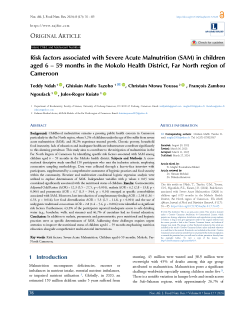Risk factors associated with Severe Acute Malnutrition (SAM) in children aged 6 – 59 months in the Mokolo Health District, Far North region of Cameroon Risk factors associated with Severe Acute Malnutrition in 6-59 months children
Abstract
Background: Childhood malnutrition remains a pressing public health concern in Cameroon particularly in the Far North region, where 5.2% of children under the age of five suffer from severe acute malnutrition (SAM), and 38.2% experience stunted growth. Chronic poverty, household food insecurity, lack of education and inadequate healthcare infrastructure contribute significantly to this alarming prevalence. This study aims to contribute to the mitigation of malnutrition in the Far North Region of Cameroon by identifying specific risk factors associated with SAM among children aged 6 – 59 months in the Mokolo health district.
Subjects and Methods: A cross-sectional descriptive study enrolled 150 participants who met the inclusion criteria, employing consecutive sampling methodology. Data were collected through a face-to-face interview with participants, supplemented by a comprehensive assessment of hygienic practices and food security within the community. Bivariate and multivariate conditional logistic regression analysis were utilized to explore determinants of SAM. Independent variables with p values ≤ 0.05 were considered significantly associated with the nutritional status of children.
Results: Gastroenteritis, Adjusted Odd Ration (AOR) = 12.3 (5.5 – 27.5, p < 0.001), malaria AOR = 6.2 (2.8 – 13.8, p < 0.006) and pneumonia AOR = 6.7 (1.3 – 34.4, p = 0.01) emerged as specific comorbidities associated with SAM. Moreover, late introduction of complementary feeding AOR = 2.98 (1.36 – 6.53, p = 0.014), low food diversification AOR = 5.3 (2.5 – 11.8, p < 0.001) and the use of unhygienic traditional concoctions AOR = 2.8 (1.4 – 5.6, p = 0.004) were identified as significant risk factors. Furthermore, 63.3% of the participants reported inadequate access to safe drinking water (e.g., boreholes, wells, and streams) and 46.7% of caretakers had no formal education.
Conclusion: In addition to malaria, pneumonia and gastroenteritis, poor nutritional and hygienic practices serve as specific determinants of SAM. Addressing these challenges requires urgent attention to improve the nutritional status of children aged 6 – 59 months emphasizing nutrition education alongside comprehensive multi-sectorial interventions.
Key words: Risk factors, Severe Acute Malnutrition, Children aged 6-59 months, Mokolo, Far-North Cameroon.
Full text article
Authors
Copyright (c) 2024 Teddy Ndah, Ghislain Maffo Tazoho, Christain Ntowa Youssa, François Zambou Ngoufack, Jules-Roger Kuiate

This work is licensed under a Creative Commons Attribution 4.0 International License.
-
Attribution — You must give appropriate credit, provide a link to the license, and indicate if changes were made. You may do so in any reasonable manner, but not in any way that suggests the licensor endorses you or your use.
-
No additional restrictions — You may not apply legal terms or technological measures that legally restrict others from doing anything the license permits.





